Originate to Arabia, eggplants (aubergine) came to Europe first, and then the Spaniards carried these veggies to America in the 18th century. Nowadays, you can choose between traditional purple as well as white varieties. Even though many gardeners treat them as annuals, these warm-weather crops are actually perennial plants.
These beautiful vegetables need high temperatures to thrive and grow healthy. Therefore, the best option is to purchase seedlings from a proven producer. If you really want to sow your own plants, you should keep pots indoors for about two months before planting.
What You Should Know About Eggplants

Eggplants (Solanum melongena) are perennial plants native to Sri Lanka and India, with white or purple flowers and large leaves. We usually use this name for its fleshy, edible fruits, but they are also well-known as brinjal or aubergine. The eggplants’ fruits contain small, soft seeds. They are edible but can be bitter thanks to nicotinoid alkaloids they contain.
Nowadays, there is a wide variety of types of these veggies which vary in sizes, shapes, colors, and tastes.
Gardeners in the US often cultivate eggplants as annual plants. Depending on the variety, they can be 15 to 55 inches (38 cm – 1.4 m) tall, with large, 4 to 8 inches (10 – 20 cm) long and 2 to 4 inches (5 – 10 cm) broad leaves.
Interestingly, some semi-wild types can grow 7 feet (2 m) high, with leaves which can have even 12 x 6 inches (30.5 x 15 cm) in diameter.
How to Plant Eggplants in Your Garden
When to plant eggplants?
The best way to start planting your eggplants is sowing seeds indoor approximately two months before the ground reaches an adequate temperature and warms up.
Seeds preparation
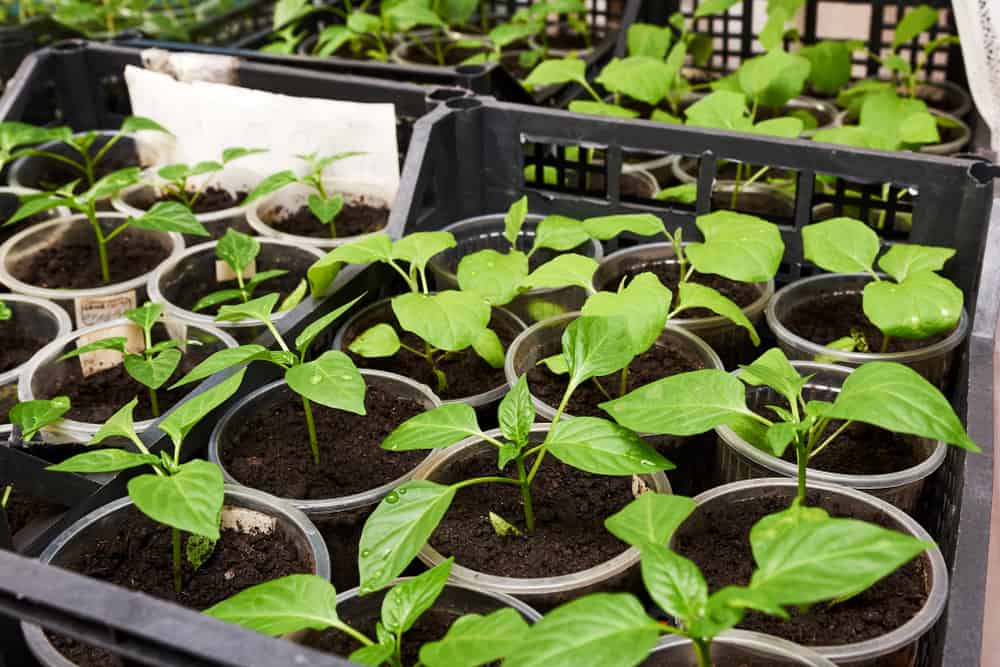
Most gardeners transplant seedlings from a pot to the garden, but you can sow seeds of this veggie directly to the desired location if you live in warm States. If not, you need to start with eggplants’ seeds indoors.
In that case, you can expect them to germinate at temperatures of 60 to 95 F (15.5 – 35 C) and emerge in a week or a few days later. One more thing! Before sowing your seeds, you should soak them overnight, and give them a better chance to grow.
I was pretty surprised when saw eggplants seeds for the first time. They are quite tiny, but you should avoid making a common rookie mistake. Even though seeds are small, you need to put them at least 0.25 inches (0.6 cm) deep in the ground.
Choose high-quality soil and put a cloche over the pot to keep the required temperatures and humidity. Add some good soluble fertilizer about two weeks after germination.
Transplant your veggies when temperatures become around 70 F (21 C) during the nights to get decent fruits. You need to set seedlings approximately 18 to 24 inches (46 – 61 cm) apart, while the distance between rows should be about 30 to 36 inches (76 – 91.5 cm).
Since you need to wait for more than two months to get vigorous seedlings, you may make a process easier and buy them in a local gardening center.
Although eggplant seedlings can grow in your garden, you may consider the possibility of using a raised bed to speed up their growth. When the soil becomes warm enough, put some organic mulch around your new plants to retain moisture.
If you decide to grow this veggie for years, you should rotate crops regularly to reduce the risk of common pests and diseases. In general, you should rotate them every few years with peas or beans if possible.
Water them moderately once in two weeks. These veggies require a lot of fertilizer, but it is better to avoid products high in nitrogen since this mineral encourages the growth of foliage but not fruits.
Useful Tips for Growing Eggplants
Grow small-fruited varieties
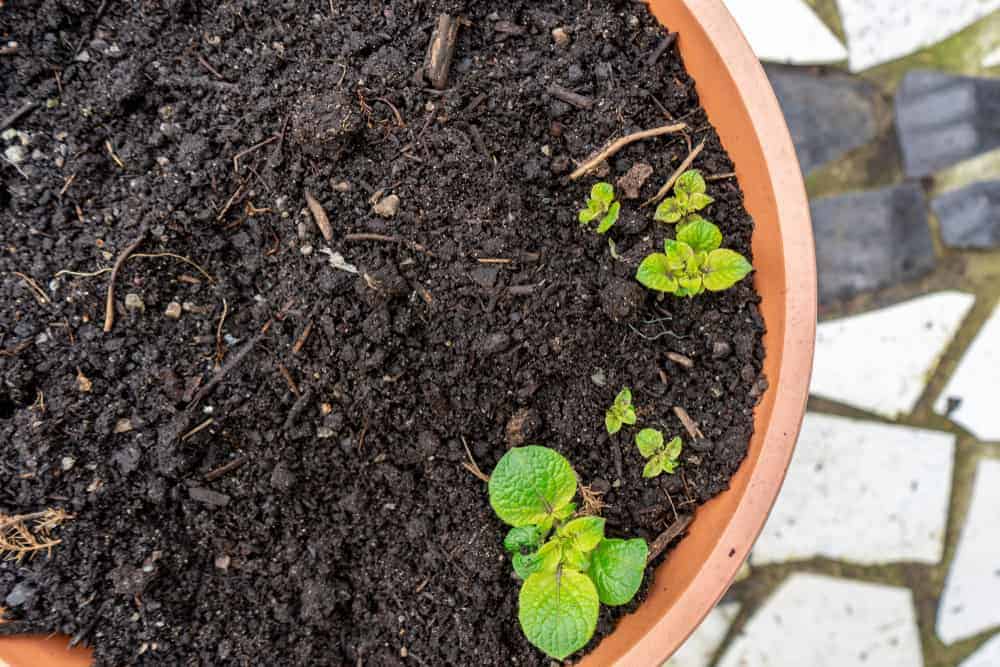
It is more comfortable and trustworthy growing varieties with small or modest-sized fruits compared to those with bigger ones. You can cultivate them in a container or small garden which is really convenient and requires less hard work.
Start sowing seeds later

Since eggplants prefer warm conditions and full sun, don’t hurry with starting eggplant seeds. I have a special secret for you! Always try to transplant your seedlings during cloudy weather, and you will be surprised how easier they will start.
Attract native pollinators

Eggplant flowers are actually self-fertile, and they need just wind for fertilization. However, when bees pollinate these veggies, you will get more abundant and high-quality fruits.
How to Care Eggplants in Your Garden
1. The right spot

Your eggplants require a part of your garden where they can get full sunlight at least six hours a day. These veggies can grow healthy and thrive only when the temperatures are really high.
2. The soil
The best soil for these veggies is fertile and well-drained, with pH from 6.3 to 6.8. If you need to correct the quality of your ground, you should go to a local garden center and buy some organic soil amendment medium such as compost, sand, perlite, or vermiculite.
Also, you can expect an abundant harvest only if you provide warm soil for them. If you live in cold climates, the better option for you is to grow eggplants in large containers.
If you prefer planting them in the garden, you may use row covers to protect your eggplants. Don’t forget to open the ends of these covers during warm days. That way, you will let the bees to pollinate your plants.
3. Mulching
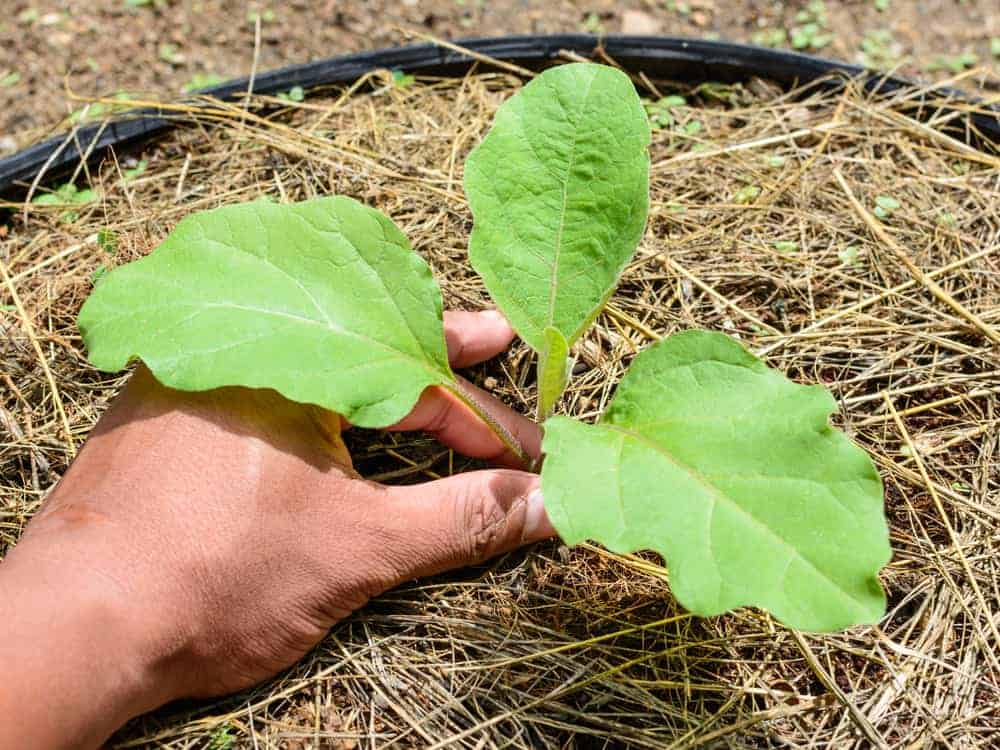
You should start with mulching right away after transplanting. Put some shredded leaves, grass clipping from untreated lawns, hay, or straw beneath your veggies once the soil becomes warm.
That way, you will keep the ground relatively cold, hold necessary moisture, and protect seedlings from weeds. In general, it is enough to provide a layer of 1 to 2 inches (2.5 – 5 cm) of mulch.
4. Watering

Your eggplants need to be watered at least once in two weeks. Provide about 1 inch (2.5 cm) of water for them weekly, and you can expect to get healthy and lush plants.
Basically, this veggie doesn’t like short watering sessions but prefers one intensive watering from time to time. Keep in mind that too frequent watering encourages the development of shallow roots, and your eggplants will have a shorter lifetime.
5. Feeding

The best moment for adding some organic, water-soluble fertilizer or mature manure to your eggplants is approximately six weeks after planting. In that period, plants will bloom, and you can notice the first small fruits, which will have a lot of benefits from extra nutrients. Do it one more time in late summer to help plants to produce delicious fruits.
6. Supporting

Since eggplants grow upright, don’t forget that they need to be staked properly. Whenever is possible, you should use bamboo sticks to hold up those veggies.
Put them into the soil as soon as possible after transplanting your seedlings, but take care that they are placed at least 1 to 2 inches (2.5 – 5 cm) away from seedlings.
Over time, they will have enough space and lean onto the stakes without disturbing other surrounding plants.
7. Weeding

It is essential to remove any weeds around your eggplants, especially right away after transplanting young seedlings in the garden. Otherwise, aggressive weeds may outgrow young plants before summer.
Use a hoe or cultivator to remove undesirable grass, or pull them out regularly by your hands. You can prevent lush growth of weeds during hot days by placing mulch of straw or clippings over the surface of the ground around your veggies.
Eggplants Harvesting

You can start harvesting your eggplants approximately 15 to 25 weeks after sowing (70 – 90 days from transplanting date). You will notice the moment when their skin becomes shiny and smooth.
To be sure, press fruit with your finger. If its surface doesn’t rebound, you can be sure that it is ripe. Don’t pull the fruit while harvesting, but cut every single piece about 1 inch (2.5 cm) close to the stem with pruning shears or a sharp knife.
Keep in mind that under-ripe and overripe veggies will have a bitter taste, so you should be very precise. If you are not sure about the exact moment for harvesting, you should ask some experienced gardener for advice.
Eggplants Storing

After picking fruits up, you should clean, rinse, and dry them carefully. Stored in the refrigerator, they will be usable for up to two weeks. In general, you can keep your eggplants in every humid place for approximately fifteen days if the temperatures are not lower than 50 F (10 C).
Pay attention that these veggies will discolor fast after you cut them. To prevent darkening, you should pour every slice with a marinade made of salt, lemon juice, and vinegar.
Eggplants Pests and Diseases
You should be prepared that your eggplants won’t ripen properly when the temperatures are too low and the soil insufficiently fertilized. You may also notice strangely-shaped fruit as a result of low moisture and inconsistent watering.
Blossom-end rot
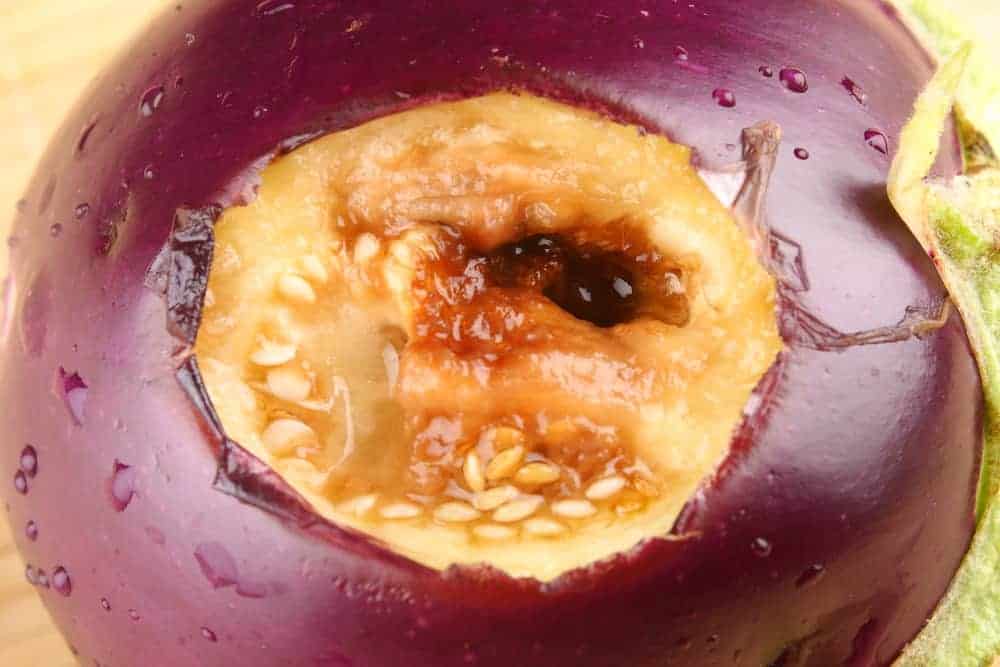
You can recognize this physiological disorder when you spot tiny, water-soaked area at the very end of your fruit. Over time, that lesion will enlarge and become black and leathery.
The main reason for this disorder is the low level of calcium in the fruit. You can help your plants by maintaining soil pH at 6.5, using mulch to reduce stress caused by drought, and avoiding ammonium fertilizers.
Verticillium Wilt

It is probably the most common disease of eggplants. These soil-borne fungi cause the occurrence of yellow blotches on leaves close to the ground but may spread upwards fast. You may avoid the damage by choosing seeds of resistant plants and by rotating crops correctly.
Cercospora leaf spot

In the very beginning, these fungi cause small oval spots on the lower part of your plants. Over time, you will see concentric zones on the foliage, which will dry out and drop down eventually.
In general, you should do everything to decrease the humidity of foliage. That means that you can fight this disease by watering your eggplants early in the morning and only at the base of every plant. You should try to avoid watering leaves.
Flea beetles

These tiny, black pests are a severe danger for your eggplants since they chew tiny holes in their leaves. However, healthy veggies are usually able to withstand the damage that these creatures cause on the foliage.
You can protect your crop by using floating row cover, dusting leaves with kaolin clay, or Beauveria bassiana as biological control.
Cutworms

They chew stems of young seedlings and may cut them off at soil line. Over time, they will attack fruits and make irregular holes into their surface.
To prevent the spreading of this infection, you should remove all plant residues from the ground after harvesting. Once they appear, you have to spread diatomaceous earth around plants and hand-pick larvae after dark. Some insecticides may help as well.
Colorado potato beetles

These yellow-and-black-striped bugs lay their eggs undersides eggplants’ leaves and damage them severely. Unfortunately, these insects have become highly resistant to insecticide, and the only proven way of removing them is hand picking.
Aphids
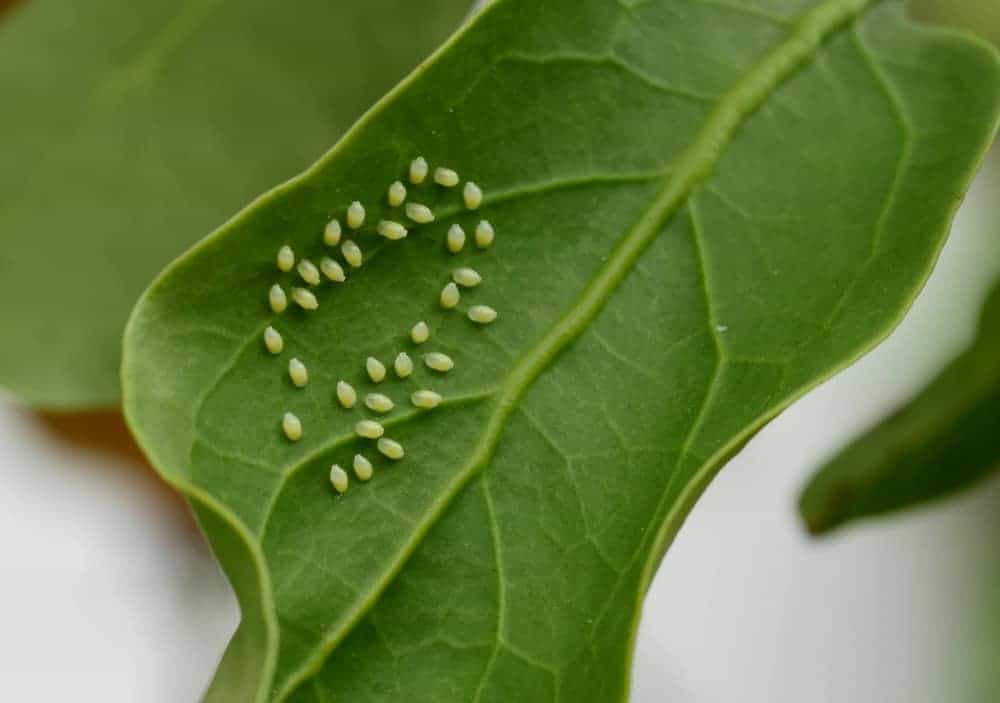
You can find these tiny, soft-bodied insects underside the foliage. They will cause the occurrence of yellow, distorted, and necrotic spots on your plants’ leaves.
Plus, these creatures secrete a sticky substance (honeydew) which will encourage the undesirable growth of sooty mold on your eggplants. You should use tolerant varieties to prevent this disease.
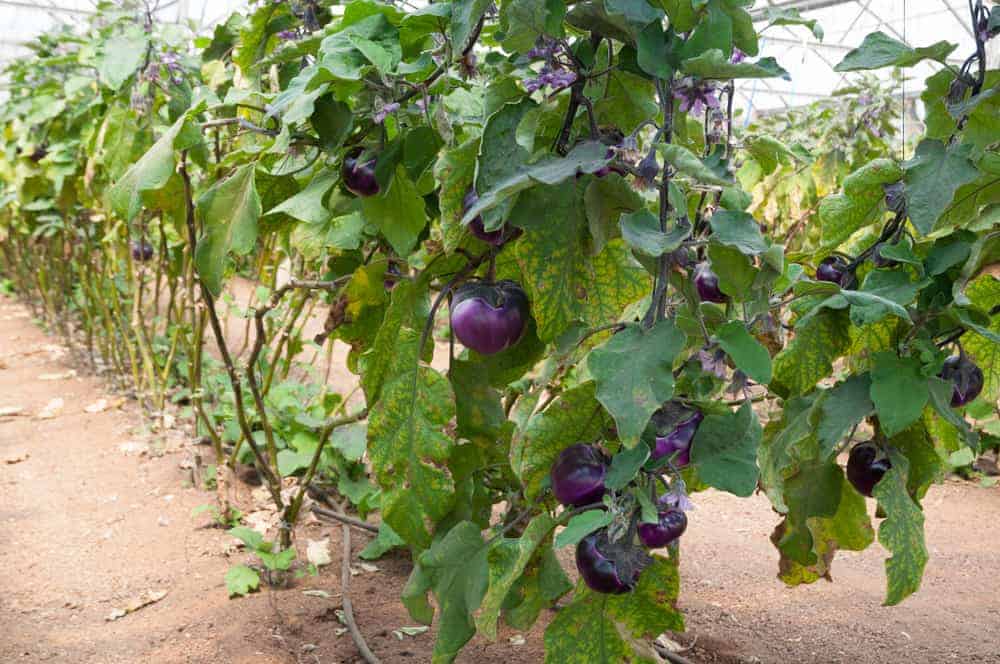
Leave a comment